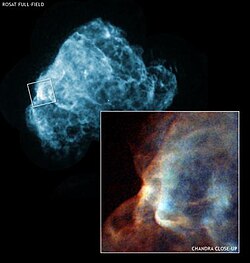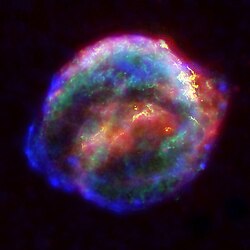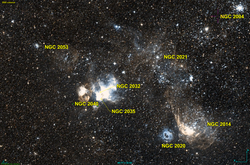Table
| Image | Name | Right ascension | Declination | First visible from Earth | Peak magnitude | Distance (ly) | Type | Galaxy | Remnant |
|---|---|---|---|---|---|---|---|---|---|
 | Sh2-264 or Lambda Orionis Ring | 05h 37m | +09° 30′ | ~1 million years ago | ? | 1,100 | ? | Milky Way | ? |
| SNR G000.3+00.0 | 17 46 15.0 | -28 38 00 | 500,000 years ago | ? | 27,200-27,700 | ? | Milky Way | ? | |
 | Sagittarius A East | 17h 45m 41s | −29° 00′ 48″ | 100,000−35,000 years ago | ? | 26,000 | tidal disruption | Milky Way | ? |
| SNR J045546-683848 | 04 55 37 | -68 38 47 | ~86,000 years ago | ? | 163,000 | CC? | Milky Way | ? | |
| Monogem Ring (SNR G201.1+08.3) | 06h 59m | +13° 56′ | ~86,000 years ago | ? | 900 | ? | Milky Way | neutron star PSR B0656+14 | |
| SNR J0450.4-7050 | 04h 50m 27s | −70° 50′ 15″ | ~45,000 years ago | ? | 165,000 | core-collapse? | Milky Way | ? | |
 | Simeis 147 or Spaghetti Nebula | 05h 39m | +27° 50′ | ~40,000 years ago | 6.5 | 3,000 | ? | Milky Way | neutron star PSR J0538+2817 |
 | IC 443 also known as jellyfish nebulae | 06h 18m 02.7s | +22° 39′ 36″ | ~30,000 years ago | ? | 3,000 | II | Milky Way | neutron star CXOU J061705.3+222127 |
| SNR J0454.6-6713 | 04 54 33 | .67 13 13 | ~30,000 years ago | ? | 163,000 | Ia | Milky Way | ? | |
 | HB 3 (SNR G132.6+01.5) | 02h 17m 40s | +62° 45′ 00″ | 33,000–27,000 years ago | ? | 7,200 | ? | Milky Way | ? |
 | W50 or Manatee Nebula | 19h 12m 20s | +04° 55′ 00″ | ~20,000 years ago | ? | 18,000 | ? | Milky Way | black hole/neutron star SS 433 |
 | 3C 392 (SNR G034.6-00.5/W44/CTB 60) | 18h 56m 10.65s | +01° 13′ 21.3″ | 20,000–16,000 years ago | ? | 10,400 | ? | Milky Way | neutron star PSR B1853+01 |
| SNR G359.0-0.9 | 17h 45m 30s | −29° 57′ 0″ | 18,000 years ago | ? | 11,000 | ? | Milky Way | ? | |
| SNR 0453-68.5 | 04 53 38 | -68 29 27 | 17,000-13,000 years ago | ? | 163,000 | II | Milky Way | ? | |
| SNR J045447-662528 | 04 54 49 | -65 66 32 | 11,000 years ago | ? | 163,000 | CC? | Milky Way | ? | |
 | Vela SNR | 08h 34m | −45° 50′ | 10,300−9,000 BCE | -12? | 815±98 | II | Milky Way | neutron star Vela Pulsar |
| SNR G359.1-0.5 | 17h 46m 5s | −30° 16′ | ca. 8,000 BCE [1] | ? | 10,500 | ? | Milky Way | ? | |
| SNR 0534-69.9 | 05 34 02 | -69 55 03 | ca. 8,000 BCE | ? | 163,000 | Ia | Milky Way | ? | |
 | CTB 1 or Abell 85 | 23h 59m 13s | +62° 26′ 12″ | 9,000–5,500 BCE | ? | 10,100 | ? | Milky Way | neutron star PSR J0002+6216 |
 | Kesteven 79 | 18h 52m 29s | +00° 38′ 42″ | 8600–7000 BCE | ? | 23,000 | ? | Milky Way | neutron star PSR J1852+0040 |
  | Cygnus Loop, including Veil Nebula | 20h 51m | +30° 40′ | 6,000−3,000 BCE | 7 | 1,470 | ? | Milky Way | possible neutron star 2XMM J204920.2+290106 |
| SNR J050555-680150 | 05 05 55 | -68 01 47 | ~6,200 BCE | ? | 163,000 | ? | Milky Way | ? | |
 | 3C 58 | 02h 05m 37.0s | +64° 49′ 42″ | 3500−1500 BCE | ? | 8,000 | ? | Milky Way | pulsar 3C 58 |
 | SNR G344.7-00.1 | 17h 03m 49s | 41° 42′ | ~3,900 -1,900 BCE | ? | 20,547 ± 100 | Ia | Milky Way | ? |
 | LMC N49 | 05h 26m 00.4s | −66° 05′ 02″ | ~3,000 BCE | ? | 160,000 | CC | LMC | neutron star PSR B0525-66 |
 | G299.2-2.9 [2] | 12h 15m 13s | −65° 30′ 00″ | ~2,500 BCE | ? | 16,000 | Ias | Milky Way | none |
 | DEM L71 | 05 05 42 | -62 52 39 | ~2,300 BCE | ? | 160,000 | Ia | LMC | ? |
| SNR G000.9+00.1 | 17 47 18.0 | -28 09 00 | 1,900 years ago | ? | 27,000-33,000 | ? | Milky Way | neutron star PSR J1747-2809 | |
 | Puppis A | 08h 24m 07s | −42° 59′ 50″ | ~1,700 BCE | ? | 7,000 | ? | Milky Way | neutron star RX J0822−4300 |
| G332.4+00.1 | 16h 15m 20s | −50° 42′ 00″ | ~1,000 BCE | ? | 16,800 | ? | Milky Way | neutron star PSR J1614-5048 | |
 | G54.1+0.3 [3] | 19h 30m 30s | +18° 52′ 14″ | ~900 BCE | ? | 22,000 | ? | Milky Way | neutron star PSR J1930+1852 |
 | LMC N132D [4] | 05h 25m 1.4s | −69° 38′ 31″ | ~900 BCE | ? | 170,000 | II | LMC | |
 | G292.0+01.8 | 11h 24m 59s | −59° 19′ 10″ | ~800–400 BCE | ? | 17,600 | ? | Milky Way | neutron star PSR J1124-5916 |
 | Kesteven 75 | 18h 46m 25.5s | −02° 59′ 14″ | 1st millennium BCE | ? | 18,900 | ? | Milky Way | neutron star PSR J1846-0258 |
 | G306.3-0.9 [5] | 13h 21m 50.9s | −63° 33′ 50″ | ~400 BCE | ? | 26,000 | Ia | Milky Way | none |
 | RCW 103 | 16h 17m 33s | −51° 02′ 00″ | 1st century | ? | 10,000 | II | Milky Way | neutron star 1E 161348-5055 |
 | SN 185 | 14h 43m 00s | −62° 30′ 00″ | December 7, 185 | ? | 8,200 | Ia | Milky Way | none |
| SN 386 | 18h 11.5m | −19° 25′ | April/May 386 | ? | 14000-23000 | II | Milky Way | neutron star PSR J1811-1926 | |
| SN 393 | 17h 14m | −39.8° | 27 February 393 | ? | ~9,700 | II/Ib | Milky Way | ? | |
 | CTB 37A (SNR G348.5+00.1) | 17h 14m 32s | −38° 29′ | ~500 CE | ? | 25,766 | II | Milky Way | neutron star PSR J1714−3830 |
| CTB 37B | 17h 13m 43.0s | −38° 10′ 12″ | ~500 CE (April 393?) | ? | 43,000 | ? | Milky Way | neutron star CXOU J171405.7-381031 | |
| E0102-72.3 | 01h 04m 01s | −72° 01′ 52″ | 1st millennium | ? | 190,000 | ? | SMC | neutron star | |
 | SNR 0540-69.3 | 05h 40m 10.8s | −69° 19′ 54.2″ | 350–1250 CE | ? | 160,000 | CC | LMC | neutron star PSR J0540−6919 |
 | W49B | 19h 11m 09s | +09° 06′ 24″ | About 1000 CE | ? | 26,000 | Ib or Ic | Milky Way | unidentified black hole |
 | SN 1006 | 15h 02m 22.1s | −42° 05′ 49″ | May 1, 1006 | −7.5 | 7,200 | Ia [6] | Milky Way | none |
 | G350.1-0.3 | 17h 21m 06s | −37° 26′ 50″ | 1000–1100 | ? | 15,000 | ? | Milky Way | neutron star XMMU J172054.5-372652 |
 | SN 1054 or M1 or Crab Nebula | 05h 34m 31.94s | +22° 00′ 52.2″ | July 4, 1054 | −6 | 6,300 | II | Milky Way | neutron star Crab Pulsar |
| SNR J0519–6902 | 450-1500 | ? | 165,000 | Ia | LMC | ? | |||
 | 3C 397 (SNR G041.1-00.3) | 19h 17m 33s | 07° 08′ | ~270-600 | ? | 27,723 | Ia? | Milky Way | ? |
 | IRAS 00500+6713 (SN 1181) | 0h 53m 11.21s | +67° 30′ 02.4″ | 1181 | ? | 8,000 ± 500 | Iax | Milky Way | none |
 | RX J0852.0-4622 or Vela Junior | 08h 52m 00s | −46° 20′ 00″ | September 13, 1271 (disputed) [7] | ? | 700 | ? | Milky Way | neutron star CXOU J085201.4–461753 |
| SGR 1806-20 | 18h 08m 39.32s | −20° 24′ 40.1″ | 1050–1650 | ? | 42,000 | ? | Milky Way | neutron star SGR 1806-20 | |
 | SNR 0519-69.0 | 05h 19m 35.14s | −69° 02′ 00.5″ | ca. 1350 | ? | 164,000 | Ia [8] | LMC | ? |
 | SN 1572 or Tycho's Nova | 00h 25m 21.5s | +64° 08′ 27″ | November 11, 1572 | −4 | 7,500 | Ia [6] | Milky Way | none |
 | SN 1604 or Kepler's Nova | 17h 30m 35.98s | −21° 28′ 56.2″ | October 8, 1604 | −2.5 | 20,000 | Ia | Milky Way | none |
 | SNR 0509-67.5 | 05h 09m 31s | −67° 31′ 18″ | ca. 1600 | ? | 160,000 | Ia | LMC | ? |
 | Cassiopeia A | 23h 23m 24s | +58° 48′ 54″ | circa 1667 | 6 | 10,000 | IIb [9] | Milky Way | neutron star CXOU J232327.8+584842 |
 | NGC 2032 (ESO 56-EN160/Seagull Nebula) | 05h 35m 20.0s | −67° 34′ 36″ | 27 September 1826 | ? | 165,000? | II? | LMC | ? |
 | NGC 2060 | 05h 37m 51.6s | −69° 10′ 23″ | 1836 | ? | 160,000 | II | LMC | neutron star PSR J0537−6910 |
| SN 1885A or S Andromedae | 00h 42m 43.12s | +41° 16′ 03.2″ | August 20, 1885 | 6 | 2,500,000 | I pec | Andromeda Galaxy | none | |
 | G1.9+0.3 | 17h 48m 46.1s | −27° 09′ 50.9″ | circa 1898 | ? | 25,000 | Ia | Milky Way | none |
 | G290.1-0.8 (MSH 11-61A) | 10h 59m 25.36s | −61° 18′ 42.6″ | ? | ? | ? | II | Milky Way | neutron star? |
 | Honeycomb Nebula | 05h 35m 46.0s | −69° 18′ 00″ | ? | ? | 150,000 | II? | Milky Way | ? |
 | Antlia Supernova Remnant [10] [11] | ? | 300–1,000 | II | Milky Way | neutron star | |||
 | N103B (SNR 0509–68.7) | 05h 08m 40.0s | −68° 45′ 12.0″ | ? | ? | 168,000 | Ia | LMC | ? |
 | SN 1987A | 05h 35m 28.02s | −69° 16′ 11.1″ | February 24, 1987 | 3 | 168,000 | II-P | LMC | neutron star |
| SN 1972E | 13 May 1972 | ? | 10,900,000 | Ia | NGC 5253 | None | |||
 | SN 1979C | 12h 22m 58.58s | +15° 47′ 52.7″ | 1979 | ? | 50,000,000 | II | M100 | neutron star |
 | SN 1998S | 11h 46m 06.25s | +47° 28′ 55.5″ | 2 March 1998 | ? | 50,000,000 | IIn | NGC 3877 | ? |
| SN 2003B | 02h 46.3m | −30° 17′ | January 5, 2003 | ? | 45,000,000 | II | NGC 1097 | ? | |
 | SN 2003gd | 01h 36m 42.65s | +15° 44′ 20.9″ | 12 June 2003 | ? | 30,300,000 | II-P | M74 | neutron star? |
| SN 2004gt | 12h 01m 50.37s | −18° 52′ 12.7″ | December 12, 2004 | ? | 63,000,000 | Ic | Antennae Galaxies | ? | |
| SN 2007sr | 12h 01m 52.08s | −18° 58′ 21.7″ | December 18, 2007 | ? | 72,700,000 | Ia | Antennae Galaxies | ? | |
 | SN 2020jfo | 4h 28m 54.05s | +12° 21′ 50.480″ | May 6, 2020 | ? | 52,500,000 | II | M61 | ? |
 | SN 2020fqv | 12h 36m 33.260s | +11° 13′ 53.87″ | March 31, 2020 | ? | 60,000,000 | IIb | NGC 4568 | neutron star |
 | SN 2023rve | 02h 46m 18.13s | −30° 14′ 22.2″ | September 8, 2023 | ? | 45,000,000 | II | NGC 1097 | ? |
| G305.4–2.2 (Teleios) [12] | ? | 7,000 or 25,000 | Ia | Milky Way | |||||
| G115.5+9.1 (Scylla) [13] | ? | ? | II | Milky Way | |||||
